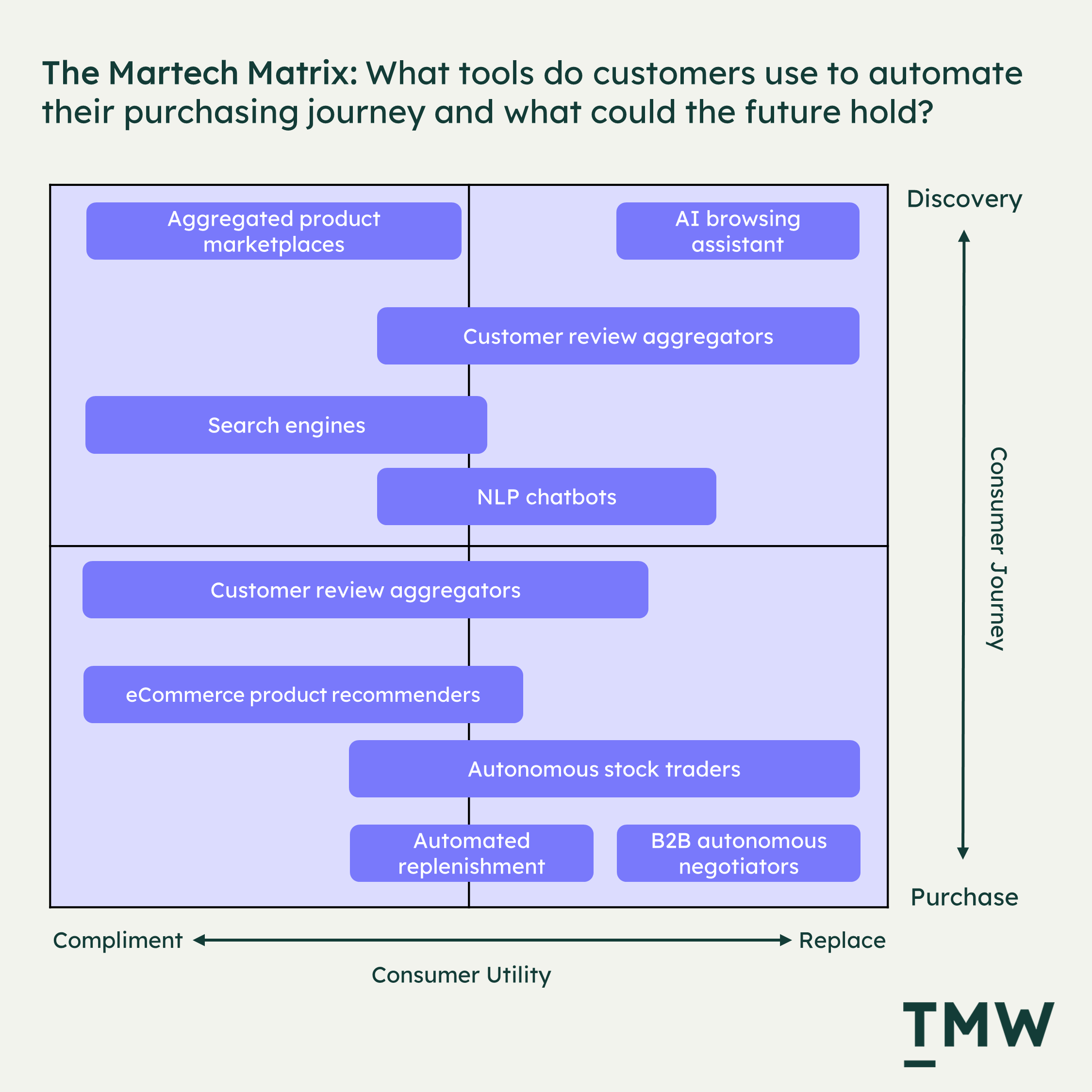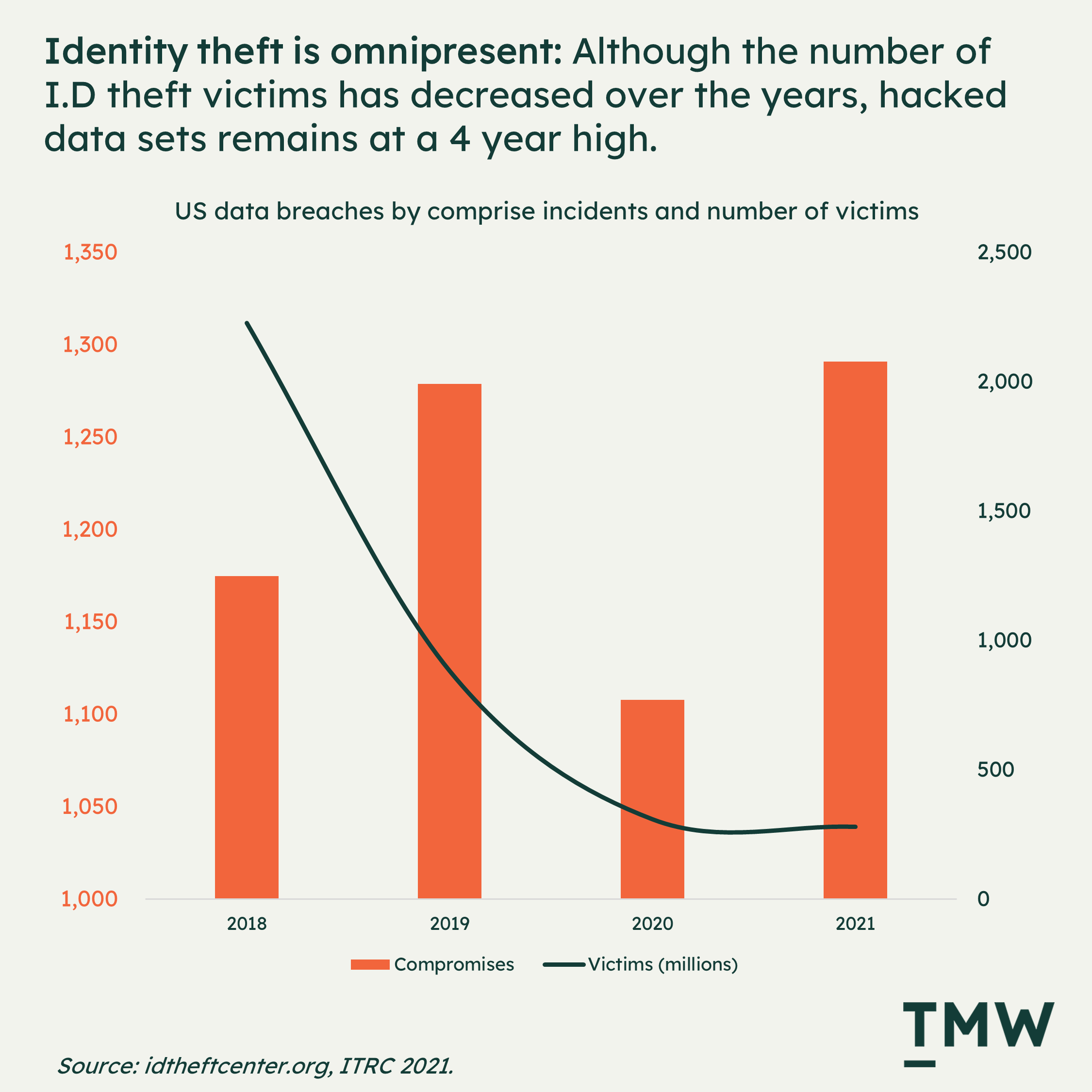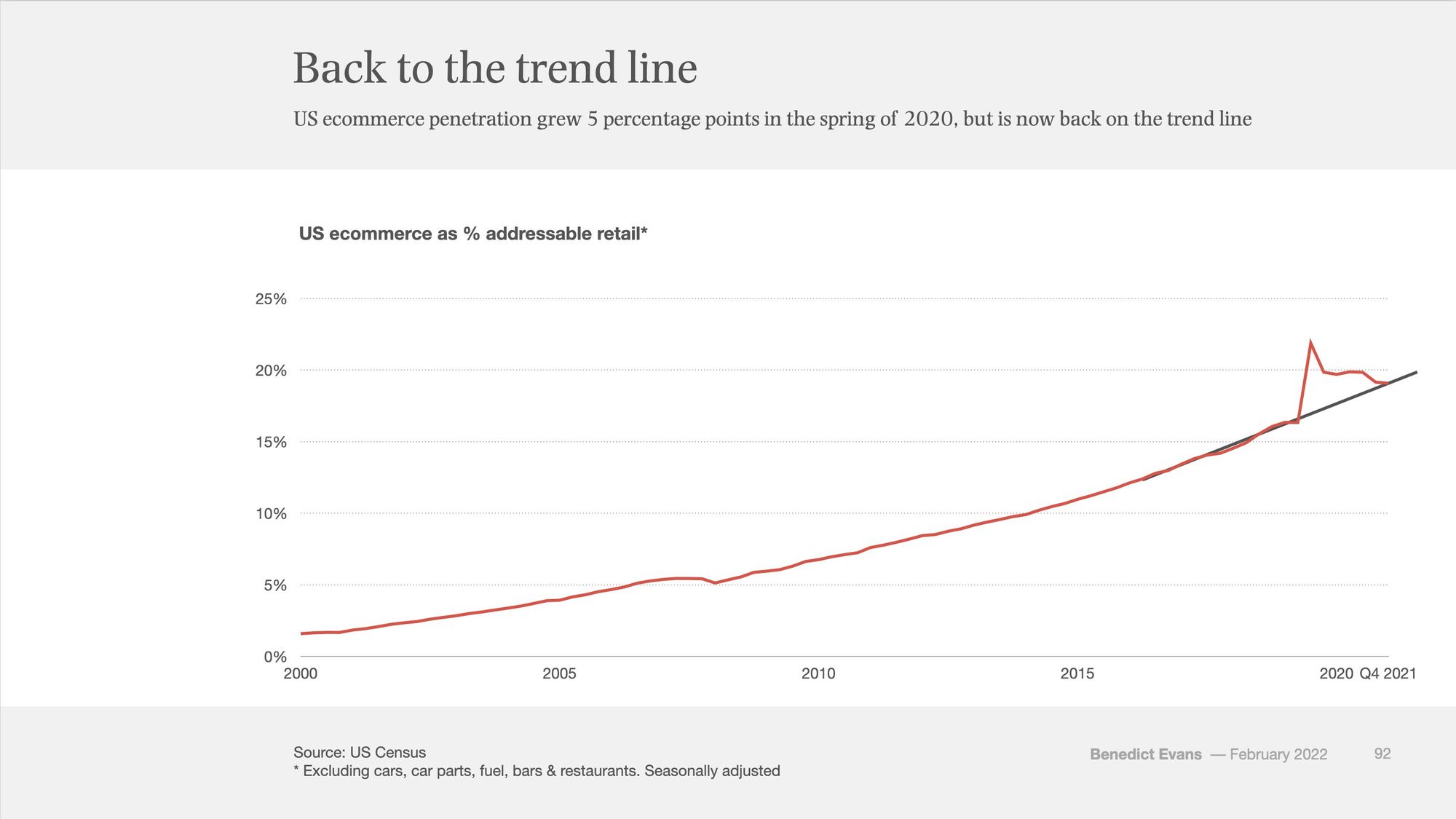TMW #074 | The artificial customer, eCommerce regression, and Spotify’s programmatic podcasting play.
Welcome to The Martech Weekly, where every week I review some of the most interesting ideas, research, and latest news. I look to where the industry is going and what you should be paying attention to.
👋 Get TMW every Sunday
TMW is the fastest and easiest way to stay ahead of the Martech industry. Sign up to get the full version delivered every Sunday for this and every TMW, along with an invite to the TMW community. Learn more here.
👋 Hello and welcome to new subscribers from the US, Australia, The UK, the Netherlands, the United Arab Emirates, Denmark, Hong Kong, Poland, and Canada! Not a subscriber? Learn more here.
Three horizons of Martech: A new MSoM podcast episode went live this week. I talk with Scott Brinker about what we should be paying attention to in 2022. Listen.
Mystery link: Trying something fun this week, at the end of this email there’s a link. Where does it go? I’m not telling, you’ll have to find out.
Here’s the week in Martech:
- The artificial customer: What it is and why we should care.
- The eCommerce regression: eCommerce after the pandemic.
- Spotify's podcasting tech. The company’s plan for a programmatic platform for podcasting (sorry for the alliteration).
- Everything else: Disney in the metaverse, the foundations of web3, why you can’t personalize anymore, the SaaS IPOs of 2021, the Martech manifesto, and Apple’s RealityOS.
✍ Commentary
The artificial customer.
Commentary note: For this week’s research piece I asked the TMW community to add their perspective. A big thank you to Scott Brinker, Balkar Singh, Hani Rifai, Philipp Brüggemann, and Jasmine Samant for sharing your views.
My introduction to the concept of the artificial customer came to me in a busy, hot kitchen back in 2005. Way back then I was training to be a chef. Surrounded by a group of young culinary trainees, we would often discuss all kinds of topics during our breaks. During one of these breaks my project partner Jan (pronounced ya-hn, we paired up often as we had similar funny-sounding names), started talking about how he was able to “hack” eBay to automatically bid for items up for auction through creating a bidding program. Jan’s exploits became quite helpful between the long days and nights of shucking oysters, roasting cauliflowers, and chopping herbs when he couldn’t be near his computer.
I didn’t know it then, but what he was describing to me was an early permutation of this concept I’m calling the artificial customer – the ways customers use technology to improve, simplify and automate their own buying experiences.
Recently Gartner predicted that this idea, what they call the “machine customer” will become a trillion-dollar industry in a decade. Signaling it as one of the most significant technological changes in customer experience for the near future.
Naturally, I had to explore such a claim.
Think of the artificial customer as the complete inverse of everything you know about Martech. People who work in the marketing or technology space are very used to talking about the technologies that brands use to reach and serve their customers. But what about the technologies that customers use themselves when interacting with products and services? These technologies are completely outside of the control of your brand but have a material impact on how you’re able to sell, serve and retain.
The types of tools customers use today can be complex or very simple. On the complex side, people will create their own autonomous website scrapers that will collect vast amounts of data and do things like aggregating customer reviews for a range of products. On the simple end, it looks like Amazon’s Dash automated replenishment system or even Google Search. Customers use a variety of services like these to make sure they never run out of a product, they are making the right purchasing decisions, and are saving time when searching for a product. It’s highly likely you’ve used one of these tools today.
As the processing power of computers continues exponentially increase, also does their accessibly and usability for more complex use cases in the artificial customer era. Customers are more capable than ever to automate their purchasing journeys, so much that McKinsey is suggesting that 80% of B2B buying decisions are happening completely online (and without the sales rep taking you out for dinner).
In many ways the concept of the artificial customer is already dated. Some of the most valuable companies in the world created value through building tools for customers to navigate the internet. Google Search was a solution for the customer to automate the ability to find information, and eventually, this led to the automation of how customers find and research products. Think about other products like Uber Eats, so much of the purchasing journey is condensed into a few tiny interactions which end in lunch delivered to your doorstep. Product replenishment programs both in B2B and B2C contexts have been a mainstay for loyal customers for decades. PayPal’s acquisition of Honey is also a very interesting use case in that the app automatically searches for discount codes and applies them to your cart at thousands of retailers. I would argue here that customers are already used to automating big chunks of the tasks needed to find, purchase, or receive products online.
What Gartner, is suggesting, however, is beyond what is happening today. The rise of more complex applications of artificial intelligence is getting to a point that it can be used by customers in ways that automate even more of their purchasing journeys. Some of the examples Gartner cites are autonomous buying agents that will manage the entire process from discovery, research, and decisioning, right through to purchasing and managing logistical interactions.
Some of the ideas in this space are quite extraordinary. What about an artificial buying agent that will purchase things based on your mood? Or fridges that replenish from Amazon on demand? Or an agent that will take your utility bills and switch providers for you based on price and benefits?
One concrete example that Gartner looks at are “roboadvisors” like Betterment, Free2Spend, Wealthfront, and many others like it that will optimize your financial portfolio for you. This is already happening in real-time and customers seem to be totally happy for an ML app to manage their finances, which tells you that the idea of the artificial customer is only getting started in a world where artificial intelligence is becoming the OS of everything.
Another emerging area is the application of natural language processing to improve chatbot utility. While chatbots had a moment mid-way through the last decade, and then everyone realized that they are a worse experience, ML programs have advanced so much that they might even make a comeback. LivePerson is one example of a natural language processing chatbot that is edging further towards a seamless experience, while Cohere, a NLP-powered chatbot company announced a $125 million raise this week which is backed by some of the largest funds in the world like Tiger Global.
Explainable AI is another emerging concept as more tools are created to explain the models in which AI operates for the everyday person. Most of the activity in this space is focused on improving how businesses understand and apply AI, but a lot of the ideas can be easily moved into the consumer domain.

The commodification of AI for the regular person could unlock some of these use cases, but there remains a question – would people actually want these things?
In many of these examples, the customer takes their hand off the wheel and hands full control over to an autonomous program. An interesting angle on this idea is the ongoing change in consumer sentiment about online autonomy over the past 30 years. A central theme that came from the TMW community for this topic was the idea of algorithmic dependency. If you told someone 30 years ago that most of the information that people consume today is decided by an algorithm, they’d probably tell you we’re living in some kind of Orwellian dystopia.
Today, the decisions that fill most of our online attention happen externally from us, and we’ve come not only to accept this reality but fully embrace it as a better way to do things. It’s very likely that our propensity to hand over freedom of choice will continue because let’s face it – making decisions about anything is hard and annoying.
If customers will become more artificial, should brands prepare for this kind of change? There’s a fundamental shift that needs to happen in the marketing department if our customers are no longer living, breathing (and mostly irrational) humans, because artificial agents run on data and pre-configured rules, not emotion and bias.
In many ways, we’re already seeing this kind of change play out with SEO. There’s an entire industry that’s dedicated to getting brands to rank on page one on Google search results. And you’ve probably seen the jokes floating around about how SEO writers will describe products for SEO crawlers. As one marketer, Jack Appleby put it, “Googling symptoms only tells you which diseases have the best SEO.” In this case, we’re already marketing to the machine, despite the fact there’s a real person typing the keyword in the search box. For SEOs, the Google page rank algorithm is the real audience.
For now, the internet doesn’t really support the idea of artificial agents using the web. There is a massive industry that is built on the premise that website visitors should be real humans, and that entertaining the idea that artificially intelligent robots are safe and secure will lead to disaster.
Identity theft through compromising company databases is already a major issue on the web – in 2021 the number of compromised companies reached a 4 year high. By handing over so much of a customer’s online autonomy, both the decisions to select products and the act of purchasing are still too great a risk for the average person to contemplate.

Marketing to the machine means that strategy will need to change. Marketers work to reach and persuade actual people in the real world, which means a whole host of things like reaching as many people as possible and spending inordinate amounts of money on creative expression to capture and retain attention. The entire discipline of conversion rate optimization is based on the fact that human behavior can be influenced through digital stimuli. This will have to change to fit into a world where things like emotion, persuasion, and even form factors like a smartphone won’t matter as much.
What will matter will be the ability to meet the criteria of autonomous purchasers. In this future, the ability to compete on price, features and fulfillment will become mission critical. The reality will be that an AI is assessing your product against thousands of other competitors in a fraction of a second to offer a trusted recommendation or instantly purchase. If this becomes a tool for the mass consumer, then the focus will shift from brand and content to product and process optimization. For the artificial customer, there’s no need for a website or an app, just a schema that will sit on an open protocol. It kind of feels like something you’d see in the Matrix (the fourth installment sucked by the way).
The biggest change in the age of the artificial customer is that the tools people use to purchase things will run across a multitude of websites and not be locked into a particular platform. This is a sharp departure from a replenishment program that’s run by Amazon or Walmart or even Google search. These apps will act as the customer to collect and optimize information from a variety of sources and independently from any one platform. Even with something like Alexa voice assistants, it’s optimized to purchase from Amazon, not the open web.
This would be a positive outcome for customers and brands in many ways, but there’s risks. Like every other algorithmically driven decision engine, what is created is a top 1% and everyone else. Across all algorithmic social platforms, ranging from YouTube, TikTok, Instagram and even platforms like Substack there is only a tiny fraction of users that earn the lions share of attention and advertising revenue. What’s not to say that this can’t be replicated with the thousands of Shopify ecommerce stores around the world when products are assessed autonomously by data points like price, availability, shipping costs and features? The artificial customer might create less opportunities for economic activity.
Should we be preparing for this artificial future? Like how my co-chef Jan wrote an app to automate his eBay bidding back in 2005, the concept is as old as the internet itself. The artificial customer follows a 30-year trend of the human desire to give away the hard parts of buying and people are more than happy to pass on the decision making. The counterfactual here is the challenge with giving more control and autonomy to software that faces an omnipresent risk to hacking. This issue alone should give us enough reason to not take Gartner seriously on this one. Links: Gartner on the machine customer.AI and human emotions.Explainable AI.CX in the age of AI.LivePerson.Cohere.The conversational AI landscape.McKinsey on B2B buying. ITRC identity theft statistics.SEO Jokes.
📈Chart Of The Week
The eCommerce regression. With COVID-19 now mostly in the rearview mirror and restrictions easing everywhere, data on retail purchasing suggests that the US market is regressing to the mean of its original trend line pre-pandemic. It is still entirely true to say both that the pandemic digitally transformed shopping behaviors and that this change is a flash in the pan. Link

📰 Latest Developments
Spotify and scaling audio ads. Two more acquisitions were announced this week in this space. Chartable and Podsights are to be purchased, both analytics products focused on attribution and marketing podcasts. It’s clear that Spotify is trying to do with audio what Google did with the search: A scalable programmatic ad platform. Link
Disney appoints metaverse executive. There are caveats that the decision is future-focused, entirely conceptual, and not (yet) grounded in reality. The amount of investment into the hypothetical metaverse from experience-centered brands like Disney is a good indicator of the validity of the idea. Link
This week in privacy. The Trade Desk announces Open Path, a trading platform that directly competes with Google. Android will undergo a tracking overhaul. Google Fonts is fined in German courts for privacy violations. The IAB forms a privacy technology working group. The French say that Google Analytics is not lawful, and Mcdonald's is fined $50 million for breaching biometric data. Links: Trade Desk. Android. Google Fonts. IAB. France vs Google Analytics. McDonald's.
📚 Reading
The foundations of Web3. David Rosenthal, one of the first scientists at NVIDIA, examines the Web3 space from a technical perspective. There’s a lot of history here that explains the white-hot moment blockchain technology is enjoying right now. Link
Why you can’t personalize anymore (podcast). Link
Brave’s analysis of Google’s next tracking technology. Apparently, Google has a while to go until Chrome’s privacy issues are fully addressed. Link
🔢 Data & Insights
A year in search. What did people search for in 2021? Link
Is Google search dying? A collation of data points suggests that the usefulness of Google search is declining. Link
The SaaS IPOs of 2021. A deep dive into the performance of the SaaS companies that did a public offering last year. Link
💡 Ideas
The Martech manifesto. The agile manifesto but for marketing technology practitioners. Link
Desperation induced focus. An alternative way to think about process. Link
Extracting value from business architecture. A proposal and a framework. Link
✨ Weird and Wonderful
Apple RealityOS. An interesting concept for how Apple might approach VR. Link
Coinbase wins the Superbowl with a QR code.Link
Trump's social media platform. Thisreminds me of another social media app. Link
Stay Curious,
Make sense of marketing technology.
Sign up now to get TMW delivered to your inbox every Sunday evening plus an invite to the slack community.
Want to share something interesting or be featured in The Martech Weekly? Drop me a line at juan@themartechweekly.com.
